First draft prepared by
Dr. Raymond J. Heitzman
Compton, Newbury
Berkshire, United Kingdom
IDENTITY
Chemical names:
International Union and Pure and Applied Chemistry (IUPAC) name:A racemate comprising (S)-alpha-cyano-3-phenoxybenzyl (1R,3R)-3-(2,2-dichlorovinyl)-2,2-dimethylcyclopropane carboxylate and (R)-alpha-cyano-3-phenoxybenzyl (1S,3S)-3-(2,2-dichlorovinyl)-2,2-dimethylcyclopropane carboxylate; and
a racemate comprising (S)-alpha-cyano-3-phenoxybenzyl (1R)-cis-3-(2,2-dichloro-vinyl)-2,2-dimethylcyclopropane carboxylate and(R)-alpha-cyano-3-phenoxybenzyl (1S)-cis-3-(2,2-dichlorovinyl)-2,2-dimethylcyclopropane carboxylate.
WL85871, alphacypermethrin (alphamethrin and alfoxylate are non-official names).
Common trade names: FASTAC· , CONCORD· , FENDONA· , RENEGADE· .
C.A.S Number: 67375-30-80 (correct stereochemistry)
Structural formula: See image below.
Molecular formula: C22H19Cl2NO3
Molecular weight: 416.3
OTHER INFORMATION ON IDENTITIES AND PROPERTIES
Appearance: White-to-cream crystalline solid
Odour: Mild chemical
Stability:
Highly stable to light and elevated temperatures. It is resistant to acidic hydrolysis but undergoes ester cleavage in environmental (basic) aquatic conditions. It has optimum stability at pH = 4. Its low solubility in water indicates a low bioavailability in aquatic situations.
Melting point: 81.5°C (pure material)
Melting range: 81.4-84.0°C (pure material)
Boiling point: 200 °C at 9.31 PA
Vapour pressure: 3.4 x 10-7 Pascals at 25 °C (pure material)
Octanol-Water partition coefficient: p = 3.16 x 105
Refractive index: 0.19 x C + 1.344 (C = concentration in kg/l up to 0.25, only in acetonitrile)
True density: 1330 kg/m3 (typical for pure material)
Solubility (g/l at 21°C):
|
n-Hexane |
6.5 |
|
Propanol-2 |
9.6 |
|
Methanol |
21.3 |
|
Ethyl acetate |
584 |
|
Toluene |
596 |
|
Fat |
78 |
|
Water |
2.06 m g/l at 20°C |
Alphacypermethrin was determined to be miscible with acetone and dichloromethane at room temperature
Structural formula:
(A) (1R, trans) (a R).

(B) (1R, trans) (a S).
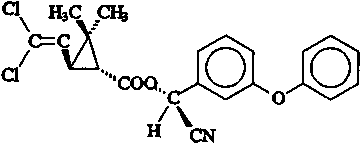
(C) (1R, cis) (a R).
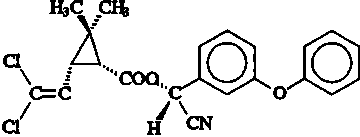
(D) (1R, cis) (a S).
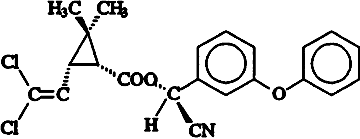
(E) (1S, trans) (a R).

(F) (1S, trans) (a S).
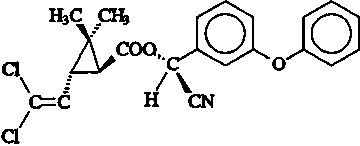
(G) (1S, cis) (a R).

(H) (1S, cis) (a S).

Chemical structure of eight cypermethrin stereoisomers. Alphacypermethrin comprises the (D) and (G) isomers.
RESIDUES IN FOOD AND THEIR EVALUATION
CONDITIONS OF USE
General
Cypermethrin is a racemic mixture of eight isomers. Alpha cypermethrin is a pyrethroid insecticide consisting essentially of two of the four cis isomers comprising cypermethrin. Alphacypermethrin is a highly active broad spectrum insecticide, effective by contact and ingestion against target pests. It is widely used in agricultural crops, forestry as well as in public and animal health.
Dosage
Applied as a pour-on preparation for cattle and sheep, as a dip for sheep, and as a spray for poultry.
METABOLISM
Pharmacokinetics
Excretion
Rats
The cis and trans isomers of 14C-alphacypermethrin labeled in the benzyl ring were separately administered to rats by the oral route. The cis pair of isomers were in a single dose of 1.7-2.5 mg/kg body weight (BW) to 6 females and 6 males. Over an eight day collection period 50-60% of the dose was excreted in the urine and 30-40% in the faeces. The majority of the radioactivity was excreted within 48 hours followed by a persistent elimination over the remaining six days. This was different from the trans isomers where the excretion was virtually complete within 72 hours (Crawford and Hutson, 1977). The difference was due to the slower hydrolysis of the cis isomers in fat tissues.
Cattle
14C-Alphacypermethrin labeled in the benzyl ring was administered orally to one lactating cow via 8 twice daily doses added to a portion of the animal's protein diet at a target dose level of 250 mg/day, ca 19 mg/kg BW. The major route of excretion of radioactivity was via faeces, accounting for 34 % of the total administered dose. A further 23% of the total administered radioactivity was excreted via urine, whereas secretion in milk accounted for < 1 %. At the end of the 8 days study period approximately 58 % of the total administered dose was recovered.
Poultry
No information.
Metabolism In Food Animals
Cattle
After oral dosing of 14C-alphacypermethrin to one lactating cow (see above), residue concentrations (g equiv/kg) were found in: muscle 19-29: liver, 560: kidney, 220: fat, 390-480: milk (up to 200) (Morrison and Richardson, 1994). Liver and kidney contained a range of components. The liver extract contained at least eight metabolites with a broad range of polarities, one component (16 % of the profile) had similar chromatographic properties to alphacypermethrin. The kidney extract contained at least nine metabolites with a broad range of polarities, one component (20% of the profile) had similar chromatographic properties to alphacypermethrin. Muscle, fat and milk contained mainly a single component (muscle 85 %, fat 91 % and milk 97 % of the extract profile), which in each case had similar chromatographic properties to alphacypermethrin.
The 14C-metabolites in urine (72-96 h after initial dosing) were characterised by co-chromatography using HPLC and TLC. The two major components (44% and 20% of the profile) had identical chromatographic properties (HPLC) to 14C-3PBA glutamic acid conjugate and 14C-3PBA glycine conjugate, respectively. A minor component (3 % of the profile) had identical chromatographic properties (HPLC) to 14C-3PBA (3-phenoxybenzoic acid).
TISSUE RESIDUE DEPLETION STUDIES
Radiolabeled Residue Depletion Studies
Two radiolabeled depletion studies in cattle (Redgrave et al., 1992; Cameron et al., 1993) were carried out, one with oral dosing and one using the pour-on application at the recommended dose (Morrison and Richardson, 1994). The studies are outlined in Table 1. The results for the pour-on veterinary drug preparation are more applicable for the evaluations by JECFA.
Table 1. Radiolabeled depletion studies in dairy cattle using 14C-Alphacypermethrin pour-on applications
|
Dose |
Route |
No. cows |
Tissues |
Sampling time (days post dose) |
Reference |
|
0.125 g b.i.d 4 d |
oral |
1 |
M, L, K, F, Milk |
0.25 (Tissues) |
1 |
|
0.150 g |
pour-on |
4 |
M, L, K, F |
7, 14, 28, 35 |
2 |
|
0.150 g |
pour-on |
4 |
Milk |
0-35 |
2 |
1. Morrison and Richardson, 1994; 2. Redgrave et al., 1992; b.i.d. = twice daily.
Milk
The concentrations of radioactivity detected in whole milk after oral dosing collected in the afternoon (34-199 m g equivalents/kg) were higher than in the larger morning samples (14-85 m g equivalents/kg) due to the difference in the sample size. Highest levels of radioactivity in fractions of whole milk were detected in cream (1100 m g equivalents/kg) and represented 93 % of the radioactivity in whole milk.
The milk samples following the pour-on application were analysed either for total radioactivity or by GC for alphacypermethrin itself [Note: The information on the measurement of cold alphacypermethrin is not given in the reference but only in the expert report]. The lower limits of determination for the two methods were 1 m g/l and 2 m g/l for radio counting and GC respectively. Mean levels rose to 7 m g/l as determined by radio counting and to 5 m g/l as determined by GC, by day 2. Ranges for the individual animals by the two methods, respectively, were < 1-12 m g/l and < 2-9 m g/l. Levels determined by radio counting fell to just on the limit of determination of 1 m g/l by day 7 (Redgrave et al., 1992). The individual and the mean values for the total residues are shown in Figure 1.
Figure 1. Total residues of radiolabeled alphacypermethrin in milk after a pour-on application
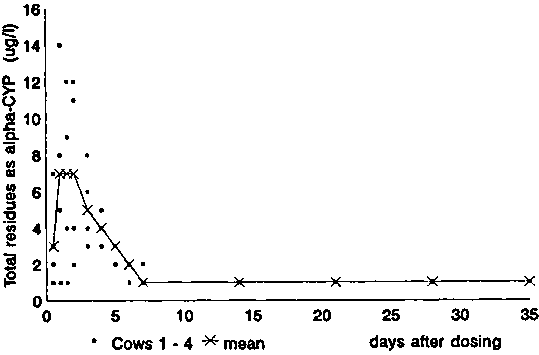
Edible Tissues
At 6 h following the final oral dose administration, the highest levels of radioactivity were found in liver, renal fat, omental fat, subcutaneous fat and kidney (560, 480, 430, 390 and 220 m g equiv/kg, respectively). Compared to plasma (80 m g equiv/kg), these levels were significantly higher. All muscle samples contained levels of radioactivity < 30 m g. High levels of total radioactivity were observed in bile (5212 m g equiv/l).
The total residues (measured as radioactivity) in the edible tissues after the pour-on application were mostly below the LOQ (Redgrave et al., 1992). The LOQ varied between 10 and 30 m g/kg. Only in the subcutaneous fat of one cow slaughtered at 35 days post dosing was a residue measured at the LOQ of 30 m g/kg. Renal and subcutaneous fat samples from cows sacrificed at 7 and 14 days after treatment were also analysed for alphacypermethrin by GC with a LOQ of 10 m g/kg but only trace amounts were found. Levels in cow 1 were < 10 and 10 in renal and subcutaneous fat, respectively. Corresponding figures for cow 2 were both 20 m g/kg. These figures are not significantly different from the radio counting estimates. Thus the highest level observed in this study was about 30 m g/kg body fat.
Other Residue Depletion Studies (with unlabeled drug)
The studies carried out by the sponsor using the recommended preparations in cattle, sheep and poultry are summarised in Table 2. Residues of alphacypermethrin were measured by GC-ECD with LOQs of 10-30 m g/kg in tissues and 1-2 m g/kg in milk. The results were not corrected for recovery although the recoveries were determined in each study.
Table 2. Residue studies using unlabeled alphacypermethrin
|
Species |
Route |
No |
Dose |
Samples |
Time of sampling |
Reference |
|
Cow |
pour-on |
5 |
0.1 g |
Milk |
1,2,3,4,7,14,21 |
1 |
|
5 |
0.15 g |
Milk |
1,2,3,4,7,14,21 |
|||
|
5 |
0.2 g |
Milk |
1,2,3,4,7,14,21 |
|||
|
Calves |
pour-on |
15 |
0.16 g |
M,L,K,F |
3,7,14 |
2 |
|
Calves |
pour-on |
11A |
0.15 g |
F (sc & perirenal) |
3,7,14,21,28 |
3 |
|
11B |
0.15 g |
|||||
|
Sheep |
pour-on |
3 |
0.2 g |
F (sc), fleece, skin |
3.7,14 |
4 |
|
Sheep |
dip |
3 |
60 mg/l dip |
F (sc), fleece, skin |
3,7,14 |
4 |
|
Sheep |
pour-on |
5 |
0.01 g/kg BW |
F (omental, perirenal) |
7 |
5 |
|
5 |
0.02 g/kg BW |
7 |
||||
|
Poultry |
spray |
40 |
? |
Egg |
2,5,10,14 |
6 |
A calves were aged 4-5 months and weighed 129-164 kg; B calves were aged 8-9 months and weighed 242-271 kg; sc = subcutaneous; References: 1. Sherren, A. J. (1988a); 2. Sherren, A. J. (1988b); 3. Cameron et al., (1993); 4. Francis and Gill, (1989); 5. White, D. A. (1987); 6. Sogeval, (1992).
Calves, aged 4-5 months, were dosed with 0.15 g of the pour-on preparation of alphacypermethrin and residues were determined in tissue samples by GC-ECD (LOQ 10 m g/kg) (Redgrave et al., 1992). The results are shown in Table 3.
Table 3. Residues (m g/kg) of alphacypermethrin in edible tissues of calves after application of a pour-on preparation - dose 0.15 g
|
|
+3 days |
+7 days |
+14 days |
|
Muscle |
< LOQ |
< LOQ |
< LOQ |
|
Liver |
< LOQ |
< LOQ |
< LOQ |
|
Kidney |
< 10-20 [10] |
< 10 - 30 [20] |
< 10 - 10 [10] |
|
Subcutaneous fat |
30 - 140 [70] |
20 - 130 [80] |
10 - 20 [10] |
|
Perirenal fat |
160 - 340 [250] |
220 - 310 [270] |
60 - 150 [90] |
The values are the ranges for five calves with the means in brackets.
The depletion of residues in both subcutaneous and perirenal fat was followed in two groups of female calves treated with pour-on applications of 0.15 g alphacypermethrin (see Table 2). The results are shown in Table 4.
Table 4. Residues of Alphacypermethrin (m g/kg) in calves and heifers after the application of 0.15 g in a pour-on preparation
|
Days post dosing |
Young calves age 4-5 months |
Heifers aged 8-9 months |
||
|
perirenal fat |
subcutaneous fat |
perirenal fat |
subcutaneous fat |
|
|
3 |
140 |
20 |
100 |
80 |
|
7 |
90 |
20 |
80 |
50 |
|
14 |
70-90 |
10-20 |
20-100 |
20-80 |
|
21 |
60-80 |
< 10-20 |
40-60 |
10-50 |
|
28 |
< 10-20 |
< 10-20 |
10-40 |
10-30 |
Milk
The residues in bovine milk were measured on a total daily milk sample collected from cows treated with 3 different doses of a pour-on preparation (Sherren, 1988a). The results are shown in Table 5. The maximum residues were observed between days 2 and 5 after treatment and were all < LOQ by day 21. The maximum value was 5 m g/l on the 2nd and 4th day after treating with the highest dose. The profile for the residues after treatment with the recommended dose of 0.15 g follows closely that seen with the radiolabeled study (Redgrave et al., 1992).
Table 5. Residues of alphacypermethrin (m g/l) in whole bovine milk after application of three doses of a pour-on preparation
|
Dose/day |
+ 1 d |
+ 2 d |
+ 3 d |
+ 4 d |
+ 7 d |
+14 d |
+21 d |
|
0.1 g |
< 2(5) |
4, |
2 |
< 2(5) |
2 |
2 |
< 2(5) |
|
0.15 g |
2 |
3 |
3,4 |
2,2,2 |
2 |
2,3 |
< 2(5) |
|
0.2 g |
3 |
2, 2, 2, 2,5 |
2, 2, 3, 3,3 |
2,3,3, 3,5 |
2, 2, 2, 3,3 |
< 2(5) |
< 2(5) |
The numbers in parentheses are the number of animals.
Sheep
Sheep were treated with either a pour-on application or a dip formulation of alphacypermethrin (see study reference 4 in Table 2) and the residues in fat, skin and wool, measured in single sheep at 3, 7 and 14 days post-treatment. The results for fat and skin are shown in Table 6.
Table 6. Residues of alphacypermethrin (m g/kg) in sheep after treatment with either a pour-on application or a dip formulation of alphacypermethrin
|
Time after dosing (days) |
Fat (sc) Pour-on |
Fat (sc) Dip |
Skin Pour-on |
Skin Dip |
|
3 |
20 |
20 |
nm |
nm |
|
7 |
< 10 |
40 |
20 |
1400 |
|
14 |
< 10 |
40 |
150 |
300 |
The values are not corrected for recovery. Recoveries in fat were 96 and 106% and in skin 78 and 80%.
In a further study (White, 1987) sheep were treated with a pour-on application at either 0.01 g/kg BW or twice this dose (see Table 2). Residues were determined in the omental and perirenal fat at 7 days after dosing. The results are shown in Table 7.
Table 7. Residues of alphacypermethrin (m g/kg) in sheep fat 7 days after treatment with pour-on applications of alphacypermethrin
|
Dose (g/kg bw) |
Omental Fat |
Perirenal Fat |
|
0.01 |
3-11 [6] |
< 0.2 - 8 [3] |
|
0.02 |
2 - 19 [6] |
5 - 18 [10] |
The values are not corrected for recovery. Recoveries in omental fat were 69 and 88 % and in perirenal fat 73 and 86%. The values are the ranges with the mean values in brackets.
Poultry
A study was carried out of the residues in eggs after a spray application of alphacypermethrin to hens (see Table 2 and Sogeval, 1992). Only the results are submitted. The residues were measured in the albumen, yolk and whole egg and also in the yolks collected from five hens sacrificed at 14 days after dosing. The results for the eggs are shown in Table 8. The residues in the yolks at sacrifice were < 5, < 5, 23, 19 and 25 m g/kg.
Table 8. Residues of Alphacypermethrin (m g/kg) in eggs and yolks after application of a spray of Alphacypermethrin
|
Time after dosing (days) |
Albumen |
Yolk |
Whole egg |
|
2 |
< 5 [< 5] |
< 5 - 45 [12] |
< 5 - 13 [4] |
|
5 |
< 5 [< 5] |
6 - 43 [26] |
8 - 15* [11] |
|
10 |
< 5 [< 5] |
< 5 - 43 [19] |
< 5 - 13 [7] |
|
14 |
< 5 [< 5] |
5-47 [16] |
< 5 - 10 [7] |
The values are probably not corrected for recovery. The values are the ranges with the mean values in brackets. The authors have used the LOD at 5 m g/kg and not the LOQ of 20 m g/kg for quantification! * The range excludes one value of 24 which was claimed to be an outlier.
Bound Residues/Bioavailability
In the studies on Cypermethrin (see the monograph) there was evidence of bound residues particularly in liver and kidney, but these usually amounted to < 20% in the liver and < 10% in other tissues. The bound residues in the liver were treated with HCl and this liberated > 90 % of the radiolabel to yield metabolites similar to those in the free fraction (Croucher et al., 1985). Thus by analogy it was probable that bound residues of alphacypermethrin were quantitatively similar.
Marker Substance and Target Tissue
The only possible option for a marker substance is the parent compound, alphacypermethrin. It represents the majority of the residue in muscle, milk and fat. Two tentative values of 16 % in liver and 20 % in kidney were determined in one cow treated orally. Thus there is really no indication of the ratio of alphacypermethrin to total residues in these tissues, nor in skin. However the total residues, using topical application, were below the LOQ in liver and kidney and therefore the sensitivity of the analytical methods could be considered in setting an MRL for these tissues. For edible tissues fat is the first choice for a target tissue, the type of fat may not be too important. Obviously milk or milk fat and the yolk of eggs are suitable for monitoring milk and eggs.
METHODS OF ANALYSIS FOR RESIDUES IN TISSUES, EGGS AND MILK
Milk
A gas liquid chromatographic (GC) method was used to determine alphacypermethrin residues in milk (SAMS 456-1). Samples of milk were treated with potassium oxalate solution and ethanol and extracted with diethyl ether and hexane. The extract was evaporated to dryness, the residue dissolved in hexane and the solution was passed through an Extrelut extraction column. Further clean up was obtained by using a Cyano Bond Elut cartridge. The isomers were separated and the residues determined by GC with electron capture detection (GC-ECD). Confirmation was by combined gas chromatography mass spectrometry (GC-MS) monitoring the ions 207 and 209 in the negative ion chemical ionization mode. The recovery of the method over a range of 5 to 20 m g/l alphacypermethrin was 95 to 105% and the limit of determination was claimed as 1 m g/l although no validation data other than for recoveries were provided.
Tissues
Method SAMS 461-1 is a GC method to determine alphacypermethrin residues in animal tissues (liver, kidney, muscle and fat). Samples were extracted by boiling with a mixture of acetone and hexane. The solvent was evaporated and the residue redissolved in hexane. For fat and muscle, a portion of the extract was partitioned with acetonitrile by using an Extrelut extraction cartridge. A normal hexane/acetonitrile partition was used for all liver and kidney extracts. Extracts were further cleaned up by liquid-solid chromatography on a Florisil cartridge before analysis with GC-ECD. Residues were confirmed by GC-MS. The recovery in fat is 80 to 115%, in muscle 85 to 100%, kidney 85 to 95% and liver 80 to 95%. The limit of detection is 10 m g/kg although no validation data other than for recoveries were provided (SAMS 461-1).
All of the results for the cold residues were not corrected for recoveries. Recoveries were given in the references and were mostly > 85 %. Thus all the values quoted are about 10-20 % on the low side of the actual corrected content.
APPRAISAL
Alphacypermethrin is a pyrethroid insecticide consisting essentially of two of the four cis isomers comprising cypermethrin. It is applied as a pour-on preparation for cattle and sheep, also as a dip for sheep and as a spray for poultry.
In rats 50-60% of a radiolabeled dose was excreted in the urine and 30-40% in the faeces over an eight-day collection period. 14C-Alphacypermethrin was administered orally to one lactating cow. The major route of excretion of radioactivity was via faeces, accounting for 34% of the total administered dose. A further 23 % of the total administered radioactivity was excreted via urine, whereas secretion in milk accounted for < 1 %.
The residues in liver and kidney contained a range of components. The liver extract contained at least eight metabolites with a broad range of polarities, one component (16 % of the residues) had similar chromatographic properties to alphacypermethrin. The kidney extract contained at least nine metabolites with a broad range of polarities, one component (20% of the residues) had similar chromatographic properties to alphacypermethrin. Muscle, fat and milk contained mainly a single component (muscle 85 %, fat 91 % and milk 97 % of the extracted residues), which in each case had similar chromatographic properties to alphacypermethrin. The metabolite profiles were not determined in sheep or poultry.
A radiolabeled depletion study was carried out using the pour-on application at the recommended dose administered to four cows. Residues were measured at 7, 14, 28 and 35 days after dosing. The total residues (measured as radioactivity) in the edible tissues were mostly below the LOQ (10-30 m g/kg). Only in the subcutaneous fat of one cow slaughtered at 35 days post dosing was a residue measured at the LOQ of 30 m g/kg. Perirenal and subcutaneous fat samples from the cows sacrificed at 7 and 14 days after treatment were also analysed for alphacypermethrin by GC with a LOQ of 10 m g/kg but, only trace amounts were found. Levels at 7 days were < 10 and 10 m g/kg in renal and subcutaneous fat, respectively, and corresponding figures for the cow sacrificed at 14 days were both 20 m g/kg. These figures are not significantly different from the radio counting estimates. Thus, the highest level of residues observed in this study was about 30 m g/kg body fat. In the milk samples following the pour-on application, total radioactivity mean levels rose to 7 m g/l by day 2 with the range < 1-12 m g/l for the individual animals. Levels fell to just on the limit of determination of 1 m g/l by day 7.
Residues as alphacypermethrin were measured in cattle, sheep and poultry after the topical application of unlabeled alphacypermethrin. The results were submitted uncorrected for recovery. After the application of the pour-on preparation no residues were detectable in the muscle and liver of young cattle and were < 30 m g/kg in kidney over the 14 day post dosing period. In two of the studies there was evidence of persistence of residues in both subcutaneous fat and perirenal fat of calves. The perirenal fat residues were 60-150 m g/kg after the first two weeks post-treatment, but then declined to about 10-20 m g/kg by day 28.
Residues in bovine milk after the pour-on treatment reached peak values between days 2 and 5 after dosing and were all below the LOQ by day 21.
Sheep which were dipped in a preparation of alphacypermethrin had higher residues in the fat, wool and skin than those receiving the pour-on application. In one study with the pour-on treatment, residues in fat were not detectable within 7 days of dosing but in sheep which were dipped the residues were 40 m g/kg in fat at 7 and 14 days after dosing. High residues were found for at least two weeks in the skin after both treatments. In another study residues at 7 days after a pour-on application were present in both perirenal fat (max. 18 m g/kg) and omental fat (max. 19 m g/kg).
In a poultry study, hens were treated with an alphacypermethrin spray and residues in eggs measured over a 14 day period. No alphacypermethrin was found in the albumen but residues persisted in the yolk for the 14 day study period.
Suitable methods for the specific analysis of alphacypermethrin in milk and the edible tissues were submitted. The methods were GC with electron capture detection followed by confirmation with GC-MS. The claimed LOQ were 1 m g/l for milk and 10 m g/kg for tissues. Recoveries were between 80 and 105 %.
Based on the available data, the only possible option for a marker substance is the parent compound, alphacypermethrin. It represents the majority of the residue in muscle, milk and fat. Two tentative values of 16 % in liver and 20% in kidney were determined as alphacypermethrin as a percentage of total residues in one cow treated orally. Thus there is limited information on the ratio of alphacypermethrin to total residues in these tissues or in skin. However, using topical application the total residues were below the LOQ in liver and kidney and, therefore, the sensitivity of the analytical methods could be considered in recommending an MRL for these tissues. For edible tissues fat is the first choice for a marker tissue. Whole milk or milk fat are suitable for monitoring milk and the yolk of eggs for monitoring eggs.
Maximum Residue Limits
In recommending MRLs the Committee took account of the following factors:
- The ADI is 0-20 m g/kg, equivalent to 0-1200 m g per 60 kg person;- The marker residue is parent drug, alphacypermethrin;
- Fat, milk and eggs are target tissues but muscle, liver and kidney should be considered;
- The metabolism of the two isomers forming alphacypermethrin is similar to that of the other six isomers in cypermethrin;
- The metabolism and radiodepletion studies are not adequate and, therefore, a very conservative estimate of the marker compound as a percentage of total residues in all food species is proposed. The percentages proposed for the estimation in individual tissues of total residues from the parent drug are; muscle, 30; liver, 10; kidney, 5; fat, 60; milk, 80; eggs, 30;
- There is adequate residue information from the non-radiolabelled studies using the recommended formulations; and
- There are analytical methods available, however, evidence of validation is needed.
The Committee recommends temporary MRLs for cattle, sheep and chickens of 100 m g/kg in muscle, liver and kidney, 500 m g/kg in fat, 25 m g/l for cows whole milk and 50 m g/kg for eggs expressed as parent drug.
An estimate of the residue intake is tabulated as follows:
|
Tissue |
Food Basket (g) |
MRL (m g/kg) |
m g |
Percent UD/TR |
Intake (m g) |
|
Muscle |
300 |
100 |
30 |
30 |
100 |
|
Liver |
100 |
100 |
10 |
10 |
100 |
|
Kidney |
50 |
100 |
5 |
5 |
100 |
|
Fat |
50 |
500 |
25 |
60 |
42 |
|
Milk |
1.5 l |
25 m g/l |
37.5 |
80 |
47 |
|
Eggs |
100 |
50 |
5 |
30 |
17 |
|
|
Total |
406 | |||
UD is unchanged drug; TR is total residues.
The above MRLs accommodate the ADI and the recommended use of this compound as a veterinary drug.
The Committee requests the following information:
1. Radiodepletion studies in sheep and poultry which extend beyond the recommended withdrawal times and using the drug in its topical formulation. The study should determine the depletion of the total residues and the parent drug;2. The radiodepletion study submitted for cattle should be reassessed to determine the depletion of the total residues and the parent drug;
3. Evidence of lack of interconversion of the cis isomeric forms to the trans forms during metabolism in the target species; and
4. Further information on the validation of the analytical methods; particulary data on the derivation of LOD and LOQs.
REFERENCES
Cameron, D.A., Redgrave, V.A., MacDonald, I.A. and Gillis, N.A., (1993). Alphacypermethrin: Concentrations of Residues in Bovine Tissues. HRC report SLL 279/931913
Crawford, M.J. and Hutson, D.H., (1977). The metabolic fate of WL 43467 (cypermethrin). Metabolism and elimination of 14C-aryl-labelled cis and trans isomers in rats. TLGR 0131.77.
Francis, W.P. and Gill, J.P., (1989). Flufenoxuron/Alphacypermethrin - Residues in Sheep Tissues Following Treatment with Pampass/Renegade Mixtures by Dip or Pour-on.
Morrison, B.J. and Richardson, K.A., (1994). WL 85871 (ACYP, FASTAC). The metabolism of 14C-WL85871 after Repeated Oral Dosing in the Lactating Cow In-life Phase and Metabolite Profiling.
Redgrave, V.A., Cameron, D.M., Elsom, L.F., Girkin, R. and Cheng, C., (1992). 14C-Alphacypermethrin: Concentrations of Residues in Bovine Milk and Tissues. HRC report SLL 240/920997
SAMS 456-1, (1988). Determination of Residues of Alphacypermethrin in Milk. Gas Liquid Chromatographic Method.
SAMS 461-1, (1988). Determination of Residues of Alphacypermethrin in Animal Tissue. Gas Liquid Chromatographic Method.
Sherren, A.J., (1988a). Residues of Alphacypermethrin in Milk Following Topical Treatment of Cows with "Renegade" Pour-on in the UK.
Sherren, A.J., (1988b). Residues of Alphacypermethrin in Cattle Tissues Following Topical Treatment of Calves with "Renegade" Pour-on in the UK.
Sogeval, (1992). Summary of Residues Trial in Hens and Eggs - Sogeval 1992.
White, D.A., (1987). Report on Residues of Cypermethrin and Alphacypermethrin in Sheep Tissues.